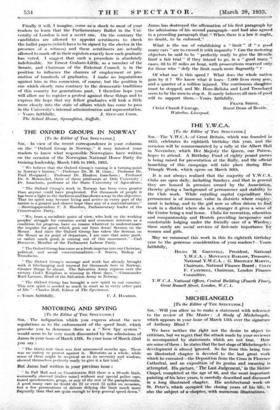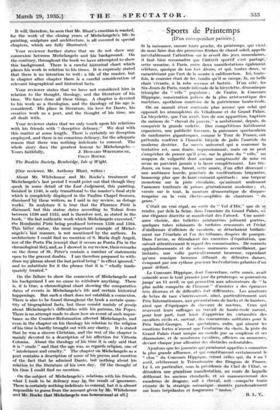MICHELANGELO
LTG the -Editor of THE SPECTATOR.]
. .• •.;
We have neither the right: nor the desire to object to criticism, but we regret that the attack made by your reviewer is accompanied by statements which are not true. Here are some of then : he states thatthe last stage of Miebelangeto's del-mlopinent is alinost ignored. So far from this being true an illpstrated:chapter is devoted to the last great work Which he executed—tile Deposition from the Cross in Florence Cathedral, and an exposition of its genius and meaning is attempted. His picture, ' The Last Judgement,' in the Sistine Chapel, completed at the age of 66, and the most important painting of his:later years, is carefully described and discussed in a long illustrated chapter. His architectural- work
St. Peter's, which occupied the cloSing years of his is also the subject of a• chapter, with numerous illustrations:
SIR,—Will you allow us to make a statement with referen0 to the review of The Master : A Study - of Michelangelo; which appears in your issue of March 15th over-the signature of Anthony Blunt -? - It will, therefore, be seen that Mr. Blunt's emotion is wasted, for the work of the closing years of Michelangelo's • life, in•- painting, sculpture and architecture, is all covered in special chapters, which are fully illustrated.
Your reviewer- further states that We do not show any connexion' between Michelangelo and his-.background., On the contrary; throughout the book we have attempted to show this background. There is a careful historical chart which plazes his work in relation to his times. It is expressly stated that there is no -intention to writ?. a life of the master, but in chapter after chapter there is a careful consideration_ of relevant biographical and historical facts.
Your reviewer states that we have not considered him in rlation to the thought, theology, and the literature of his time. We have dime all these things. A chapter is devoted to his work as a theologian; and the theology of his age is considered:. His place in literature, his love for Dante, his creative work as a poet, and the thought_ of his time, are all dealt with.
Your reviewer states that we only touch upon his relations with his friends with deceptive delicacy." We deal with this matter at some length. _ There is certainly no deception employed, and there is no consehius--deiicacy,- for the adequate reason that there was nothing indelicate to conceal. The whole story does the greatest honour to' Michelangelo.—
COLIN ROCKE.
The Ruskin Society, Bembridge,Isle of Wight. [Our reviewer, Mr. Anthony Blunt, writes
About Mr. Whitehouse and Mr. ROcke's treatment of
Michelangelo's hist period I would point out that they speak in Softie detail of the Last Judgement, this painting, finished in 1540, is only transitional to the master's final style which is CiOmplitely displayed in the Pauline Chapel frescoes, dismissed 'bY these writers, as I said in my review, as dotage work.' In SeirlptUre it is true that the Florence Pieta is tii.'Cussed; but this statue dates according to Tolnai from between 1550 and 1555,' and is therefore not, as stated in the book, " the last authentic work which Michelangelo executed," the Rondatihil Pieta being prodUced between 1556 and 1564. This latter- statue, the most important example of Michel- angelo'S 1ait'manner, is not mentioned by the authors. In architecture I could find no mention of S. Maria degli Angell, nor of the Porta Pia (except that it occurs as-Ponta Pia in the chronological list), and, as I showed in my review,-theirremarks on the dome of St. Peter's contain a number of statements Open to the gravest doubts. I am therefore prepared to with- draw my phrase about the last period being " in effect ignored," and to substitute for it the phrase that it is " wholly inade- quately treated."
On the- failure to show the connexion of Michelangelo and • his background I see no cause to withdraw anything. There is; it is 'true; a chronological chart showing the comparative dates of events in Michelangelo's life and 'certain historical happenings. But such a chart does not establish a connexion. There is also to be found throughout the.book a certain quan- tity of biographical facts, but these consist mainly of gossip about Michelangelo's difficulties with his patrons, the Popes. There is no attempt made to show how an event of such impor- tance as the Counter-Reformation affected Michelangelo, and even:in the chapter on his theology his relation to the religion of his time is hardly brought out with any clarity. It is stated that he was a sincere Christian, and the rest of the chapter is mainly devoted to a description of his affection for Vittoria Colonna. About the theology of his time it is only said that it is " crude" and that the age. was, as regards religion, one of ".intolerance and cruelty." The chapter on Michelangelo as a poet contains a description of some of his poems and mention of the fact that he admired Dante, but nothing about his relation to the literature of his own day_. Of the thought of his time I could find no mention.
• On the. subject of Michelangelo's relations with his friends, what I took to be delicacy may,.. the result of ignorance. There is certainly nothing indelicate to conceal, but it is almost impossible to guess from the account given by.Mr. Whitehouse and Mr; Rocke that Michelangelo was homosexualat all.] .







































 Previous page
Previous page